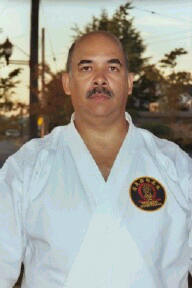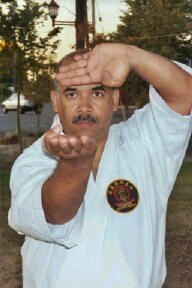
MARTIALFORCE.COM
PRESENTS
INTERVIEW WITH
NELSON MELENDEZ SENSEI

by Shihan William Rivera
MartialForce.com
Online Martial Arts Magazine
Hello, I am William Rivera, a Yudansha with over 30 years of martial arts training residing in Staten Island, NY. I am also a friend as well as student of Eddie Morales Shuseki Shihan. In my years of training, teaching and learning, I have met many martial artists, many of whom have empowered people in their practice and teaching. I hope to introduce you to them in articles to come. One such individual embodies both Empowerment and Hard-Core.
Having learned, trained, and been a friend to Nelson Melendez Sensei for over twenty-five years, I thought it would be appropriate to begin with him.
As anyone who knows him can attest to, Melendez Sensei is one of the most cordial Karate Masters within the Martial Arts. His enthusiasm with anyone who shares his passion or interest for the martial arts, is seen in his success as an instructor and in the way audiences light up when he demonstrates his art.
The following is a short biography, and believe me I could write pages on his accomplishments and what he has contributed to the martial arts as well as to youth in America. Another time)
Melendez Sensei was born in New York City in 1958, to Amalia and Tony Melendez, of Puerto Rico. Having a father who was an ex boxer and a mother who understood the hard and soft sides of life, Melendez Sensei was initiated into the art of fighting (yes, to his father it was an art) at a very young age.
Melendez Sensei’s martial arts training began in 1970, at the local YMCA in Williamsburg Brooklyn. There, renowned instructor and competitor, Master Thomas LaPuppet, instructed him in the art of Shotokan. One year later he would travel to Master George Coffields infamous Tongs Dojo on St.Marks Street in Brooklyn where he trained for two years.
In 1974, Melendez Sensei entered the Ying Yee Kwoon, blocks away from his home in Williamsburg. Ying Yee was one of the premiere dojo's on the East Coast, offering both Hung Gar and Goju training under the auspices of Anthony Lau Kyoshi, also a Master in USA Goju. Melendez Sensei furthered his studies under Archie Rullan Sensei (current Master of Rullan Goju-Do) Head Instructor for the Goju faction of Ying Yee.
In 1977, Melendez Sensei enlisted in the Army, and in 1978, during his assignment at Fort Polk Louisiana, began studying the Korean martial art of Hapkido. In 1980,while stationed in Korea, he continued his studies in Hapkido. Recognizing his talent and commitment, his instructor, Mr. Kim, awarded Melendez Sensei an Honorary Black Belt after his departure from Korea.
When he completed his tour of duty with the US Army, Melendez Sensei returned to New York and resumed his studies at Ying Yee. He dedicated himself to learning Yoshido Goju-Ryu under Anthony Lau Kyoshi (Grand Master of Yoshido Goju-Ryu). In 1983, he earned his Black Belt in Yoshido Goju-Ryu.
Melendez Sensei continues his study of Yoshido Goju and is presently a senior instructor for Yoshido Goju-Ryu, ranked as a 4th Dan.
Mr. Nelson Melendez is a Law Enforcement officer with the Department of Adult and Juvenile Detention, in Seattle Washington. The King County, D.A.J.D. is the second largest correctional facility on the West Coast and the largest in the Pacific Northwest.
As a law enforcement officer, Mr. Melendez is all too familiar with the violence involving youth. He has devoted a considerable part of his life to training youth both in Seattle and New York, in the benefits of martial arts instruction.
In closing, Melendez Sensei continues to stress to young people that training in the martial arts has been proven to be a more positive method in learning how to resolve their conflicts peacefully as well as building strong moral character.
Nelson Melendez Sensei Interview :
1) M.FORCE-What was Karate like when you first began?
Melendez Sensei - As a young man during my early karate lessons, I found the whole experience to be almost magical. I learned to do things with my body that I had no idea I could do, almost “super hero” like! As time past and my interest grew, I realized how unique karate truly was.
2) M.FORCE-What style do you practice and teach?
Melendez Sensei - I practice and teach Yoshido Goju-Ryu Karate. The Soke (founder of system) is Anthony Lau Kyoshi, Master Lau or Kyoshi (the title Kyoshi literally translates to “Master Instructor” or “Wizard”; also denotes as teacher of teachers), as many of his black belts refer to him. Master Lau holds various titles and is recognized as a 10th Dan and Hanshi (head master) in USA Goju as well as a Master of Hung-Gar (tiger-crane) kung fu.
3) M.FORCE-What is Yoshido Goju-Ryu?
Melendez Sensei - Yoshido can translate as meaning reason, significance or cause. Yoshido Goju-Ryu has been interpreted to mean “The Way of Righteousness of the Hard and Soft Style” Yoshido Goju-Ryu means everything above and more. Yoshido goes back to the very essence or core of Goju-Ryu. This essence is the significant reason that Goju-Ryu has developed some of the best masters, instructors, students and competitors in the martial arts world. As is known, Goju-Ryu Karate was formed by the influence of various Chinese styles in combination with the naha-te principles. Over the years, the popularity of Goju-Ryu has caused a growth and Goju-Ryu has been accepted around the world. This growth has created many offshoot systems of Goju-Ryu where training methods have been modified. Through this modification, the basics and fundamental components that give Goju-Ryu its foundation have been lost. Yoshido Goju-Ryu goes back to the principles developed by the Masters such as Higashionna and Miyagi, while understanding the evolution of Karate into modern time.
4) M.FORCE-What differences or development have you seen in the method of training?
Melendez Sensei - Some differences I see in training today are that classes are not being taught with a degree of strictness, courtesy and difficulty as when I began training. I also see that classes are shorter in length, for example, seeing classes that are 45 minutes long. I am a firm believer that training requires time and 45 minutes are used up in warm up and basic development alone. I have also noticed that there is a lack of “makiwara” training. I hold a strong belief that it is an effective form of training. Incorrect makiwara training can cause damage to your hands and health in general. However, this is due to the type of training, not the makiwara itself. With the correct training and instruction (a Sensei who knows your limit and how to push you while not overdoing it), you will be able to condition your hands for striking, develop a solid base, and forge an iron will. With the new materials and safety standards of today, makiwara training can be one of many supplemental exercises (Hojo-Undo) that helps us keep our ties to the old, while developing us for the future.
5) M.FORCE-Have you changed the way you teach over the years?
Melendez Sensei - The manner in which I teach has not changed in terms of how I present instruction. However, as those of us who teach karate or run a tournament, we have become aware of today’s world of potential lawsuits and liability. There is tremendous emphasis placed on adhering to proper procedures, and making sure our schools and instructors are up to or above code.
6) M.FORCE-Do you teach children differently than to adults?
Melendez Sensei - Yes, I do. Children, in general, have shorter attention spans than adults, yet, can absorb and retain vast amounts of information. Therefore, I make sure to control the amount of information and detail presented at each session and this usually results in positive outcomes. Adults, on the other hand, have longer attention spans and can handle a greater amount of information and detail during instruction. For example, with children, I introduce a variation of drills using a specific technique. This helps to prevent boredom while building a strong foundation. With adults, I tend to be more detailed oriented while emphasizing repetitive technique. I stress the building and strengthening of the foundation for adults and children
7) M.FORCE-What was it like to study karate under Master LaPuppet?
Melendez Sensei - As his name implies, he was a master puppeteer. He would take a student, such as myself, controlling my moves to enhance my technical abilities, strengthening my foundation while teaching me to control my own strings. Master LaPuppet was hard and fast. He was a true warrior.
8) M.FORCE-You have practiced various Martial Arts, why have you chosen Yoshido Goju as your art?
Melendez Sensei - Through the various martial arts such as Shotokan, Kung Fu, Hapkido, Judo, Boxing (yes it is a martial art) and Goju, I have derived benefits unique to each. In Yoshido, I have found what I believe to be a complete art. The foundation of Yoshido compliments and gives you an understanding of the essential principles contained in other martial art systems.
9) M.FORCE-Would you recommend cross training in another form of Budo?
Melendez Sensei - Cross training is a good way to experience different martial art forms. You should always maintain an open mind to other styles and their training methods. I have always believed that an individual should find the one art form that will become their own, and strive to master it. Goju Ryu will take me a lifetime to fully learn.
10) M.FORCE-Have you ever wanted to give up Karate?
Melendez Sensei – Never.
11) M.FORCE-Do you have a favorite Kata?
Melendez Sensei - Yes, Seiunchin. One of the main principles of Goju Ryu and Yoshido Goju is that “the secret principles of Goju Ryu lie in the Kata”. I practice them all and work at mastering them. As in the past, a master would teach a kata to a student, which he thought suited him, without a predetermined regimen, Seiunchin was taught to me. The devastating attacks representing the “Go” hard aspect, and the hand movements that flow representing the “Ju” soft aspect, go hand in hand in the representation of Goju Ryu. Seiunchin contains close-quartered striking, takedowns, sweeps and throws. Though thought to be devoid of kicks the ashi barai (foot sweep) as well as the suri ashi (sliding steps forward) is applicable to parries, traps, sweeps and kicks. Seiunchin involves the use of the hard and soft aspect of breathing and develops the mind, body and spirit.
12) M.FORCE-Which Karate instructor influenced you the most?
Melendez Sensei -Master Anthony Lau.
13) M.FORCE-Which person do you admire the most?
Melendez Sensei - I admire my father for his achievements and I admire my mother for supporting his growth.
14) M.FORCE-What benefits have you derived from your training in Karate and how has it effected your life?
Melendez Sensei - I have acquired many benefits. One of them being meeting wonderful people through out my career in martial arts, being able to train in different parts of the world. I credit my karate training for my focus and discipline.
Edited: Lydia Alicea
